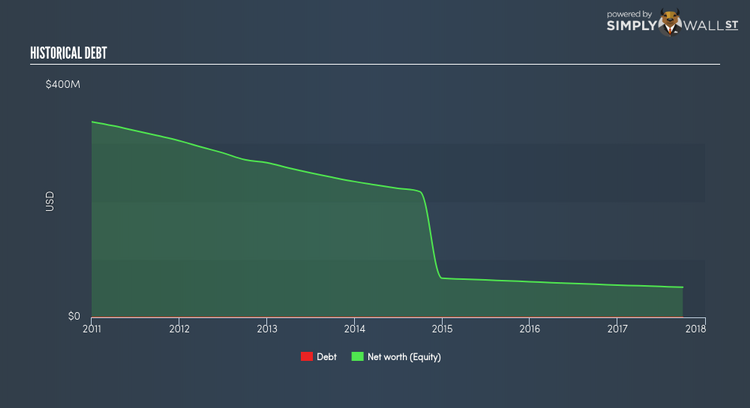What You Must Know About ECA Marcellus Trust I’s (NYSE:ECT) Financial Health

ECA Marcellus Trust I (NYSE:ECT), which has zero-debt on its balance sheet, can maximize capital returns by increasing debt due to its lower cost of capital. However, the trade-off is ECT will have to follow strict debt obligations which will reduce its financial flexibility. While ECT has no debt on its balance sheet, it doesn’t necessarily mean it exhibits financial strength. I recommend you look at the following hurdles to assess ECT’s financial health. Check out our latest analysis for ECA Marcellus Trust I
Does ECT’s growth rate justify its decision for financial flexibility over lower cost of capital?
Debt capital generally has lower cost of capital compared to equity funding. Though, the trade-offs are that lenders require stricter capital management requirements, in addition to having a higher claim on company assets relative to shareholders. ECT’s absence of debt on its balance sheet may be due to lack of access to cheaper capital, or it may simply believe low cost is not worth sacrificing financial flexibility. However, choosing flexibility over capital returns is logical only if it’s a high-growth company. ECT delivered a negative revenue growth of -23.37%. While its negative growth hardly justifies opting for zero-debt, if the decline sustains, it may find it hard to raise debt at an acceptable cost.
Can ECT pay its short-term liabilities?
Given zero long-term debt on its balance sheet, ECA Marcellus Trust I has no solvency issues, which is used to describe the company’s ability to meet its long-term obligations. But another important aspect of financial health is liquidity: the company’s ability to meet short-term obligations, including payments to suppliers and employees. With current liabilities at $1.3M liabilities, it appears that the company has maintained a safe level of current assets to meet its obligations, with the current ratio last standing at 1.42x. Generally, for oil and gas companies, this is a reasonable ratio as there’s enough of a cash buffer without holding too capital in low return investments.
Next Steps:
Are you a shareholder? As a high-growth company, it may be beneficial for ECT to have some financial flexibility, hence zero-debt. Since there is also no concerns around ECT’s liquidity needs, this may be its optimal capital structure for the time being. Moving forward, its financial position may change. I suggest keeping abreast of market expectations for ECT’s future growth.
Are you a potential investor? ECA Marcellus Trust I is a fast-growing company, making financial flexibility a valuable option for the company. Furthermore, its high liquidity means the company should continue to operate smoothly in the case of adverse events. To gain more conviction in the stock, you need to also examine ECT’s track record. You should continue your analysis by taking a look at ECT’s past performance to conclude on ECT’s financial health.
To help readers see pass the short term volatility of the financial market, we aim to bring you a long-term focused research analysis purely driven by fundamental data. Note that our analysis does not factor in the latest price sensitive company announcements.
The author is an independent contributor and at the time of publication had no position in the stocks mentioned.

